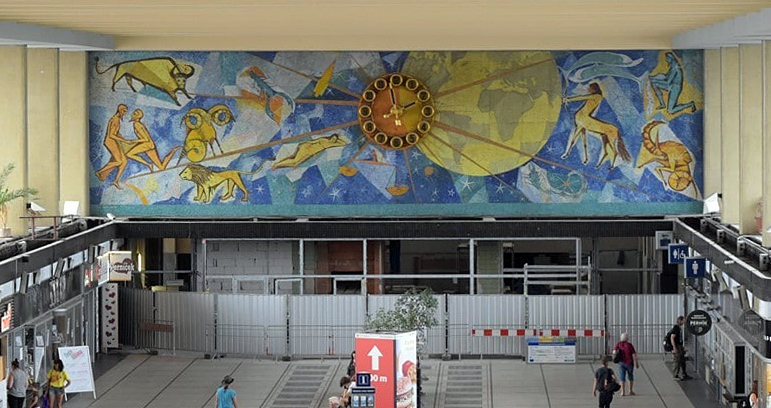
The large wall mosaics from the 1950s at the train station in Pardubice have been restored
 |
| photo: Mosaic Studio |
Pardubice – Two large mosaics on the walls of the train station in Pardubice have been restored after several months. The significant functionalist building is undergoing modernization. The restoration of the decoration, composed of stone and glass pieces, was part of this process. Work continues, and on Monday, workers will take down the scaffolding and set it up in another section of the hall. Marek Fibich, the site manager from Chládek and Tintěra, Pardubice, told ČTK.
"Last summer, restoration surveys began. The mosaics are a combination of glass chips and natural stone. They range in size from half a centimeter to two centimeters. It is a work of art, beautiful from a distance as well as up close. The mosaics were in relatively good condition, but some areas had stones that were blown away," said Fibich.
The mosaics are located on the sides of the ticket hall. They measure approximately 20 meters in length and six meters in height. One depicts a map of railway junctions with 55 cities, while the other presents a stylized starry sky with a zodiac and a clock. The author of the map mosaic is Richard Lander, and the starry sky was created by Jaroslav Moravec. The clock features gold leaf.
Restorers locally drilled joints in areas where the mosaic surfaces were damaged and disassembled them. They injected the areas with a special mortar to secure the irregular pieces. Experts thoroughly cleaned the mosaics with steam. Damaged tiles were produced by glassworks. Restorers had everything carefully numbered to ensure that the correct piece in the right color was placed in the empty spot.
"The most difficult work is the injection. About 25 percent of the surface was done this way. The map of the republic was in worse condition; it has a dilation there. The second part of a newer building connects there, and it likely leaked secretly. Previously, mosaics were glued with cement mortar; frost-resistant and flexible adhesives did not exist back then," Fibich said.
The post-war train station building with a hotel was designed by architect Karel Řepa together with Josef Danda and Karel Kalvoda. The state contract was drafted in the late 1940s, and construction work lasted until 1958. Following a recent modernization of the railway junction that lasted nearly four years, another phase follows – the renovation of the train station's dispatch building. It will cost one billion crowns excluding VAT.
"The roof of the building is complete, the frames on the windows have been secured, and they will be glazed starting in September. We are working on the commercial units where the ticket offices and other shops were located. We will be renewing the floor; we will dig out 22 centimeters down to the top of the ceiling structure of the basement, and there will be modern underfloor heating installed," Fibich said.
The repair of the train station building is being done while in operation; part is closed, but always in such a way that people can walk to the platform, buy a ticket, and get basic refreshments. According to Fibich, the work on the floor will be complicated and time-consuming. The floor will feature replicas of the mosaics, including parts made of glass blocks. "We managed to acquire mosaics that look 95 percent the same as the original. We would like to have the floor completed by the end of the year, but I fear we will face many surprises, as it is an old building," Fibich stated.
On Monday, the company will start dismantling the scaffolding in the dispatch hall and move it from one side to the other. The builder will designate corridors so that people can move through. By the end of next year, the train station will be repaired, including the eastern and western extensions and the spacious basement where a parking lot was supposed to be. However, there will likely only be storage spaces due to a tree standing at the planned entrance location.
The English translation is powered by AI tool. Switch to Czech to view the original text source.
0 comments
add comment









